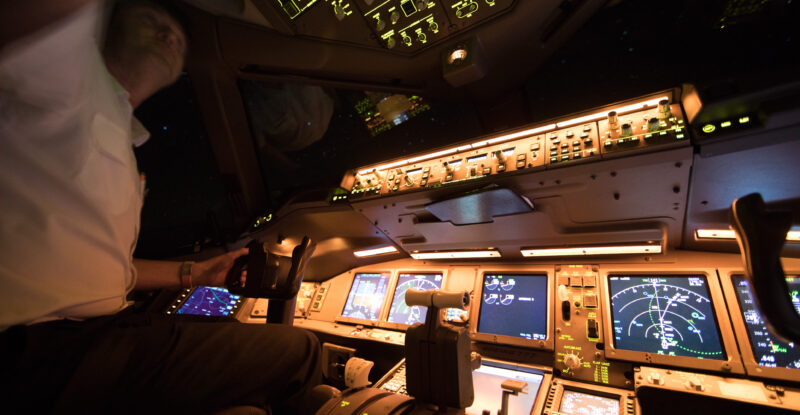Low-latency Low Earth Orbit (LEO) satellites are certainly having a moment in civil aviation, as SpaceX offers a frictionless onboard Internet option, and major aero ISPs develop roadmaps around OneWeb’s forthcoming LEO-powered inflight connectivity service.
But in the ever-important cockpit communications and safety services realm, LEO has long had a presence in the form of Iridium Communications’ global network of crosslinked L-band satellites, initially via the McLean, Virginia-based company’s first-generation network and now via its 66 operational NEXT generation satellites with 14 spares. An incident this spring involving the temporary outage of a rival safety-supporting geostationary (GEO) satellite in Asia-Pacific, known as I-4 F1, served as a reminder to industry of the value of Iridium’s LEO network in the aviation ecosystem.
At 21.14 UTC on Sunday 16 April, the I-4 F1 satellite (then owned by Inmarsat, now owned by Viasat) suffered a partial loss of power. This in turn invoked automatic procedures on the satellite that led to the suspension of services for East Asia and the Pacific region. All safety services were restored by 19 April. But during the outage, many operators were forced to switch to antiquated high frequency (HF) radio when flying over the Pacific.
Iridium competes with Inmarsat in the cockpit, as their L-band links are safety-certified for Future Air Navigation System (FANS) datalink messaging, ACARS, safety voice, and other cockpit comms functionality. During the I-4 F1 outage, Iridium customers continued to rely on Iridium satcom in the region, whilst Inmarsat customers were directed to have their pilots use HF voice for position reports every 15 minutes. And despite having successfully launched its I-6 F1 and I-6 F2 satellites with L-band payloads, Inmarsat did not hive off I-4 F1 aero traffic to these birds.
For Iridium, the incident in the Pacific serves as a clear example of why it built its constellation from the very beginning as a mesh network — wherein each satellite maintains contact with some adjacent satellites. The incident, says Iridium executive director aviation line of business John Peterson, “speaks to the value of a mesh LEO network and it speaks to the value of having built in redundancy both at the satellite vehicle level as well as the ground earth station level and having a reliable network”. This kind of architecture means that operators using Iridium “stopped using HF a long time ago”, he tells RGN.
“Our voice quality is better, response time is better, and availability is better, and the reason why is we are a Low Earth Orbit constellation with low latency, and the satellites are meshed so you don’t have to have visibility of just one satellite. And if that satellite has any issue, there are other satellites to pick up the slack.” Effectively, the information can bounce around the network until it reaches a working teleport.
In a worst-case scenario, where a satellite encounters an issue preventing it from passing off traffic, a civil aircraft would be without service for up to a maximum of seven minutes before it is in the footprint of another Iridium satellite, notes Peterson. “So, the max lack of visibility is seven minutes and because we have spare satellites in the orbital planes, it isn’t difficult for us to move one out and put in a spare. Because we’re an L-band network and a safety network, we have built redundancy into what we do.”
In contrast, says Peterson, “when you put up something that is geostationary, it is a single point of failure. If something happens, that satellite coverage goes down. That is something that Iridium fixed from the beginning, and we only get better as we move forward.” He suggests:
Single point solutions are very problematic in aviation because something is going to go wrong. And that’s why it’s important we don’t have single point solutions, whether the solution you have has built-in redundancy so you don’t have single point failure, or you have redundancy through multiple communications links.
The I-4 F1 satellite outage certainly also highlighted the importance of enhancing pipe redundancy on aircraft. Some industry players are keen on a dual-dissimilar satcom approach — exploiting both Inmarsat (now Viasat) and Iridium L-band, potentially ultimately allowing over-ocean operators to remove an HF system. Operators that carry both systems now often favor Iridium “because of voice quality and availability”, according to Peterson.
Other aviation stakeholders favor the notion of using cabin connectivity (Ku/Ka-band) as backup to a primary L-band safety system. But Peterson suggests industry consider the benefits of dual-similar safety satcom, whereby an operator uses a higher data rate Iridium solution as primary and “a very inexpensive low data rate” Iridium solution as backup, given the inherent “reliability, availability and redundancy” of Iridium’s mesh network.
At present, Iridium’s NEXT constellation is supporting the satellite operator’s legacy short burst data service. This year it expects to start FANS-1/A flight trials for its new, nextgen Certus service. But even though it’s supporting safety with a legacy service until it can obtain the necessary data to receive final clearance for Certus safety from the US FAA, Iridium “operates in aviation at a level of safety and communication that is just unprecedented” versus HF radio.
Is the writing on the wall for HF on longhaul aircraft flying over oceans?
Related Articles:
- Operators switch to HF as Inmarsat confirms I-4 F1 satellite outage
- Iridium prepares for new opportunity: longhaul narrowbody ops
- Viasat aero footprint sees vast expansion as Inmarsat purchase closes
- Rivada looks to change the game in inflight connectivity
Featured image credited to istock.com/Rathke











